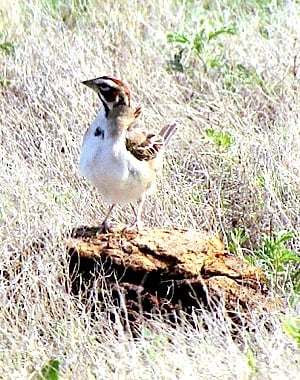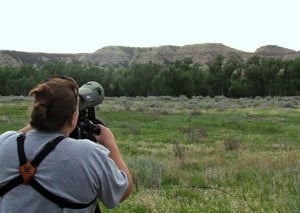Look through enough range maps for birds (or any organism, for that matter), and you’ll start to see some of the same lines showing up over and over. One of those common lines cuts through my neck of the woods in the northern part of Michigan’s Lower Peninsula. That line marks the northern extent of many southern species’ breeding range and the southern terminus of either the breeding grounds or the wintering grounds for a slew of boreal birds.
Another noteworthy line runs down the divide of the Cascade Mountains in Washington and Oregon. Habitats on the wet windward side differ greatly from the rain-shadowed east, leading to an abrupt east-west boundary for the range of many species. The Appalachians have their own range map artifact in the form of a trough extending down to the Great Smokies for birds that otherwise breed only in the northeast. You’ll see that particular anomaly for everything from great Rhododendron and Snowshoe Hares to Chestnut-sided Warblers.
The line that took me on a road trip early this June is one that runs north and south just a hair (depending on your map’s scale!) east of Montana’s eastern border. It seems quite a few Rocky Mountain birds venture ever so slightly into the southwestern corner of North Dakota, but not much farther.
You’d think there was a giant force-field there preventing eastward movement, but it’s really just the North Dakota badlands, home of Theodore Roosevelt National Park. The whole of North Dakota is a birder’s paradise with some of the continent’s best prairie and pothole habitat preserved in the United States’ largest collection of National Wildlife Refuges. But after getting my fill of the prairie-dwellers, I ventured a little further to Theodore Roosevelt to do a whole different kind of birding.
Two of the first birds to greet us were a couple of female (that’s a nice way of saying “gray”) specimens of Lazuli Bunting and Mountain Bluebird. It wouldn’t be long before we’d get great views of males of both of these striking blue birds. Both are western and mountain birds that an easterner may catch of a glimpse of when one turns the wrong way during migration and ends up in Cape Cod National Seashore.

A Lark Sparrow hopped atop some bison dung for a better glance around his surroundings. Kirby Adams photo.
There was one very confused Lazuli Bunting there this past February! Vagrants like that are exciting, but I like to see birds doing what they do in their home range. So I drive west, past hours and hours of prairie and sunflower fields, until suddenly the plains turn into badlands and, just as abruptly, Mountain Bluebirds become a common sight.
It’s fascinating how quickly your excitement over new species can turn to familiarity, apathy, and then sometimes contempt as you discover which birds are the “trash birds” at a given location. Birders use the term “trash bird” to either good-naturedly or with a hint of annoyance refer to a bird that is ubiquitous at a particular place and time.
While the bluebirds and buntings never reached that level, after one morning in the park’s South Unit, we’d seen enough Lark Sparrows and heard enough Spotted Towhees to last until our next sojourn west. Every time I lowered my binoculars grumbling about “just another Lark Sparrow,” I had to remind myself that back home we drive two hours just to see a rare eastern remnant of these birds in Ohio. And when a bird as stunning as the Lark Sparrow is your trash bird for the trip, you know you’re in a great place.
The badlands is an unforgiving environment for all but the hardiest plants and animals, hence the “bad” in badlands. This is as true for birds as for any other animal. Exposed, rocky landscapes with poor soil don’t support the kind of lush plant growth that many songbirds prefer for food and shelter. When faced with such an inhospitable landscape and the desire to see a wider variety of birds, birders tend to look for islands. Not islands in the sense of a small land mass in a body of water, but rather an oasis of lush habitat in a field of rock. These refuges of shelter and abundant food provide a lifeline to a bird and a convenient concentration of bird diversity in a small are for the bird-watcher.

Spotting scopes come in handy when you're looking for eagles in Theodore Roosevelt National Park. Kirby Adams photo.
Looking at a satellite image of the South Unit of Theodore Roosevelt, it becomes clear where we’ll be looking for the greatest bird diversity: all along the Little Missouri River.
The Little Missouri is a respectable river in June, but sometimes little more than a creek in a mudflat by late summer. Regardless, it’s a source of water in an arid land and it is lined with Cottonwood trees for most of its length through the badlands.
The most accessible area around the river is the aptly-named Cottonwood Campground in the park’s south unit. A quick evening perusal of the picnic area didn’t disappoint, with Western Wood-pewee, Yellow-breasted Chat, Black-capped Chickadee, American Redstart, and Yellow Warbler joining the other suspects we’d come to regard as “usual.”
The highlight of the picnic area was a Black-headed Grosbeak. An extremely close cousin of the common and popular Rose-breasted Grosbeak of the east, the Black-headed is near the eastern edge of its range in the badlands.
The mixing of familiar birds from eastern forests and those more associated with the Rockies make the Cottonwood groves along the Little Missouri a textbook study in the meeting and overlapping of ranges. Just when you think all the action is in the trees at the Cottonwood Campground, you might be reminded to gaze a few hundred feet up to the bluffs across the river to the nesting grounds and patrol routes of the park’s Golden Eagles.
You can find Golden Eagles during migration around the Great Lakes, but somehow it just feels like the West when you see these gigantic birds soaring above the bluffs where they nest. While the wing markings, golden head, and size are enough to identify the eagles from a distance with binoculars or the naked eye, a spotting scope helps to give a good look at birds perched on the highest bluffs or hovering above their massive nests.
Another good method for finding Golden Eagles is to sit near one of the prairie dog towns not far from the Little Missouri. When an eagle flies overhead, there’s a noticeable change in the prairie dog behavior. “Alarm” would be an understatement!
The riparian zone along the river may offer the best diversity, but there are a few birds that simply don’t care that much about water and vegetation. Take the Rock Wren, for instance, that is more interested in…well, rocks.
The rock scree that collects all over the rugged slopes of the badlands is the preferred habitat for the Rock Wren, a bird known for decorating its nest site with distinctive rocks and animal bones to make it easier to find.
I have to admit I never actually saw a Rock Wren in Theodore Roosevelt. Picture a rocky slope with several scree gullies, and then stand back a hundred yards. Now, spot the small grayish bird sitting on one of the small rocks singing. See the problem with this?
We did manage to hear several Rock Wrens, but could never get our eyes on one. In one case, I thought I had him, but it turned out to be a Say’s Phoebe. While Eastern Phoebes are a common harbinger of spring in woods and wetlands over two-thirds of the United States, their close relative, the Say’s Phoebe, is more at home in hot, dry canyons and grasslands. Say’s are beautiful little flycatchers, but I still wish I could have found that darned Rock Wren!
Lest we forget that there’s a northern counterpart to Theodore Roosevelt National Park’s South Unit, there’s some great birding there, as well.

Don't forget to watch for other "natives" in the parks when you're looking in the trees and sky for birds. This bison didn't take kindly to being interrupted by birders. Kirby Adams photo.
Only ten percent of visitors to the park make the roughly 90-minute drive up to the North Unit, which makes for some birding in solitude. We had the pleasure of exploring it during intermittent thunderstorms, which further reduced the traffic.
American Kestrels and Northern Harriers patrol sagebrush meadows all along the Little Missouri Valley, while the same crew of birds can be found in the riparian woodlands as in the south. The North Unit is a lot more heavily treed than the south and consequently a good mix of forest birds like Cedar Waxwings, woodpeckers, and orioles are easier to spot along the scenic drive.
Theodore Roosevelt National Park claims that more than 185 species of bird live in or pass through the park annually. We managed to see 71 (72, if you count that Rock Wren) in three days in June. Not too shabby when you have the awesome (literally) scenery of the badlands as a backdrop.
We also got a lesson in the wisdom of being alert to your surroundings at the Cottonwood Campground. While slinking through the trees in pursuit of a singing Yellow-breasted Chat, my wife and I emerged into a small clearing and were greeted by much snorting and violent snapping of twigs. It turns out the Chat was singing right above some lounging bison.
Our inadvertent violation of the “safe distance” rule resulted in only some frayed nerves for us and some withering, annoyed glares from the bison once they stormed off to what they considered a safe distance. Sometimes bison are smarter than people. The birder’s habit of walking around with both eyes fixed straight up in the treetops isn’t the wisest maneuver in bison and rattlesnake country!


 Support Essential Coverage of Essential Places
Support Essential Coverage of Essential Places







Comments
Great story, I'd love to do some birding up there - especially if there are Baird's Sparrows and Longspurs around!
Nick, do it! Chestnut-collared Longspurs do pop up around there, and over much of ND. McCown's Longspur would have been a real prize for me, but we didn't get any of them. They did have some this spring south of Roosevelt near Bowman and the Rhame Prairie area. Sadly it can be pretty miserable (and dangerous) to explore some of those areas with the intense oil traffic. All the more reason to go sooner rather than later. Five more years of oil boom and there won't be much of anything to see in western ND.
There isn't really any suitable Baird's habitat in the park, but a few have turned up just east of there. It's getting harder and harder to find reliable places for them from what I gather. I got some up north in Lostwood NWR which used to be a slam-dunk for Baird's, but with cuts to the fire program there the grass litter is building up and they aren't nearly as common there as they once were.
OT: Nick, we need to hear about your National Battlefield CBC adventures in one of these birding columns! (I presume that's you...unless several Nick Lund's are birding and National Park advocates.)